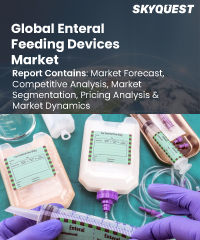
Report ID: SQMIG35A2771
Skyquest Technology's expert advisors have carried out comprehensive global market analysis on the enteral feeding devices market, covering regional industry trends and market insights. Our team of analysts have conducted in-depth primary and secondary research to provide regional industry analysis and forecast of enteral feeding devices market across North America, South America, Europe, Asia, the Middle East, and Africa.
In 2023, North America maintained its position as the dominant Enteral Feeding Devices Market player, commanding a substantial share of 37.2%. The region's market growth is propelled significantly by the increasing number of premature infants requiring critical care. Statistics from the Centers for Disease Control and Prevention (CDC) highlight this trend, indicating that approximately 1 in 10 babies in the U.S. were born prematurely.
Asia Pacific is forecasted to witness the most rapid growth in the coming years within the enteral feeding devices market. The region boasts a substantial patient pool and a burgeoning geriatric demographic. Transformations in lifestyle patterns across Asia Pacific are contributing to a surge in the prevalence of several diseases, including cancer, diabetes, gastrointestinal disorders, and autoimmune conditions.
REQUEST FOR SAMPLE
Enteral Feeding Devices Market size was valued at USD 4.1 Billion in 2023 and is poised to grow from USD 4.35 Billion in 2024 to USD 7 Billion by 2032, growing at a CAGR of 6.1% during the forecast period (2025-2032).
The competitive environment of the global enteral feeding devices market is dynamic and characterized by the presence of a mix of well-established brands, emerging players, and niche producers. Innovation is a key competitive factor. Leading brands invest in research and development to introduce new flavors, packaging formats, and health-focused variations to cater to changing consumer preferences. They often set the trends in the industry. 'Fresenius SE & Co. KGaA ', 'Cardinal Health ', 'Nestlé S.A. ', 'Avanos Medical, Inc. ', 'Danone S.A. ', 'Becton, Dickinson and Company ', 'B. Braun Melsungen AG ', 'CONMED Corporation ', 'Cook Medical ', 'Moog Inc. ', 'Boston Scientific Corporation ', 'Baxter International Inc. ', 'Vygon ', 'Applied Medical Technology, Inc. ', 'Amsino International, Inc. ', 'Danumed Medizintechnik GmbH ', 'Medline Industries, LP ', 'Fuji Systems Corporation ', 'Kentec Medical ', 'Dynarex Corporation ', 'Vesco Medical, LLC ', 'Medela AG ', 'Romsons'
The escalating prevalence of chronic diseases stands as a significant driver behind the burgeoning demand for enteral feeding devices. A consistent upward trend in chronic ailment occurrences, encompassing conditions such as Alzheimer’s disease, Attention Deficit Hyperactivity Disorder (ADHD), osteoporosis, osteoarthritis, central nervous system disorders, and various other health conditions, necessitates meticulous clinical dietary management. Amongst individuals grappling with these chronic health issues, the geriatric population stands out as a significant demographic relying extensively on enteral feeding devices.
Enteral feeding devices serve the purpose of delivering essential nutrition through the gastrointestinal (GI) tract, employing a tube directly inserted into the stomach or small intestine. These devices are recommended for patients experiencing difficulties in consuming sufficient calories orally, yet possess the requisite gastrointestinal function necessary for digestion and absorption. Widely utilized across various healthcare settings, including intensive care units (ICUs), operation theatres (OTs), critical care units (CCUs), and even in-home care environments, enteral feeding devices play a pivotal role in providing crucial nourishment to individuals who encounter challenges in traditional oral intake.
In 2023, North America maintained its position as the dominant Enteral Feeding Devices Market player, commanding a substantial share of 37.2%. The region's market growth is propelled significantly by the increasing number of premature infants requiring critical care. Statistics from the Centers for Disease Control and Prevention (CDC) highlight this trend, indicating that approximately 1 in 10 babies in the U.S. were born prematurely.
Want to customize this report? This report can be personalized according to your needs. Our analysts and industry experts will work directly with you to understand your requirements and provide you with customized data in a short amount of time. We offer $1000 worth of FREE customization at the time of purchase.
Feedback From Our Clients

Report ID: SQMIG35A2771
sales@skyquestt.com
USA +1 351-333-4748